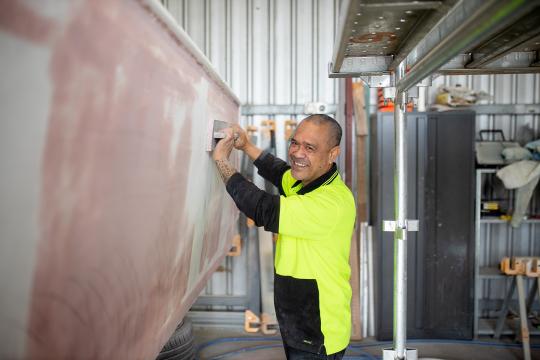Did you know that working on diversity and inclusion in small business can deliver greater productivity, innovation and workforce wellbeing?
Recent research from the International Labour Organization and consulting firms McKinsey and Deloitte has found that companies who demonstrate inclusion through diversity perform better.
So, what does diversity and inclusion mean and how can you benefit from it?
What is diversity and inclusion?
The Diversity Council of Australia describes diversity as being your mix of people, and inclusion as being about creating an environment that enables that mix to work – for organisations, customers and employees.
While diversity refers to all the ways we differ (like cultural background, age, education, sexuality, gender and profession), inclusion can only occur when all people in your business feel respected and valued. Because they go hand in hand, diversity and inclusion are often referred to by the acronym “D&I”.
Why is it relevant for my small business?
Diversity is a strategy that can help and grow talent, and increase competitiveness to progress your business growth. By opening your mind up to employing different types of people, you can introduce new ideas and experience to your organisation. In short, it’s good for business.
There is also a growing expectation from consumers for brands and businesses to be more ethical and inclusive. By providing a welcoming and inclusive business environment for your customers, you can best position your business for growth, innovation and resilience into the future.
How can you support D&I in your business?
We have put together five strategies to help support diversity and inclusion in your business.
1. Leadership
Whether you have a team of staff or it’s just you, you can take a lead on D&I by uncovering any unconscious bias you may have. Our unconscious bias can influence our decisions, the language we use, and how we behave, which can all have a powerful impact on your business and the customer and employee experience. By being a role model to your customers, your staff and your networks, you are leading by example and helping to drive an approach best suited to your business.
2. Staff
By ensuring that all employees feel valued and motivated, you can help drive innovation and better business outcomes. You can win the war for talent by considering inclusive hiring practices, recruiting outside of your typical networks, and considering staff and staff rosters with fresh eyes.
Research from McKinsey has found that diverse teams are “stronger at anticipating shifts in consumer needs and consumption patterns that make new products and services possible, potentially generating a competitive edge.”
In addition, the Diversity Council of Australia’s Inclusion@Work Index 2019-2020 found that workers in inclusive business or organisational cultures are three times more likely to indicate their team provides excellent customer/client service and three times less likely to leave their current employer.
You may want to consider:
- reviewing job descriptions so that roles can be shaped in different ways to accommodate flexible working hours
- blind screening CVs to pre-empt stereotypes and assumptions
- talking about inclusion on a new staffer’s first day
- updating your HR policies to be inclusive
- using inclusive language, including normalising the use of pronouns, and
- celebrating staff bringing their full selves to work.
3. Customers
By being more inclusive to a diverse range of customers, you can help drive business growth. Start by thinking about how you can engage your current customers differently and attract new customers by delivering inclusive products, marketing and branding.
Consider how you speak to your customers – is there a place on your website, your social media accounts, your business front door or reception to indicate you are an inclusive small business? Can you display a Pride Flag on your window? Do you attend expos and community fairs of diverse groups to show your support? Do your social media posts include alternative text for images, and image descriptions?
If you have a bricks and mortar presence, is it accessible to people with disability? Would you benefit from a ramp to support people with mobility challenges to enter your shop? Would you consider ‘quiet shopping’ time with dimmed lights and low music for people with sensory sensitivity or who are autistic. If you or your staff speak more than one language or know AUSLAN, can you promote this to encourage diverse customers who may otherwise be disengaged due to communication barriers?
4. Partners and suppliers
Consider your business networks and their approach to diversity and inclusion. If you position your business as one that supports the Aboriginal and Torres Strait Islander community, is it fitting that one of your suppliers publicly displays racist attitudes? Your customers might not think so.
How can your supply chain impact inclusion? Are you sourcing product from reputable companies with a track record for treating people ethically and inclusively, and is this displayed in their leadership and staffing?
Aim to build strategic alliances with other businesses that share your enthusiasm for diversity and inclusion, to benefit your bottom line and draw more customers to your business.
5. Days of significance
You may also want to consider how you can commemorate and celebrate days of significance that are relevant to your business. Take a look at the Diversity Council of Australia’s Diversity and Inclusion Calendar and plan to publicly recognise certain days.
Read more
- Learn how local governments are helping small businesses be more accessible
- Recruiting and managing staff
- 6 tips to handle job applications
- Marketing and promotion strategies
- Diversity Council Australia
- Centre for Accessibility Australia
- Transforming Enterprises through Diversity and Inclusion - International Labour Organization
- Diversity wins: How inclusion matters - McKinsey
- Consciously Unconscious - Deloitte
Image note: Kerry from My Little Bookshop established her bricks and mortar store with wheelchair accessibility in mind.




